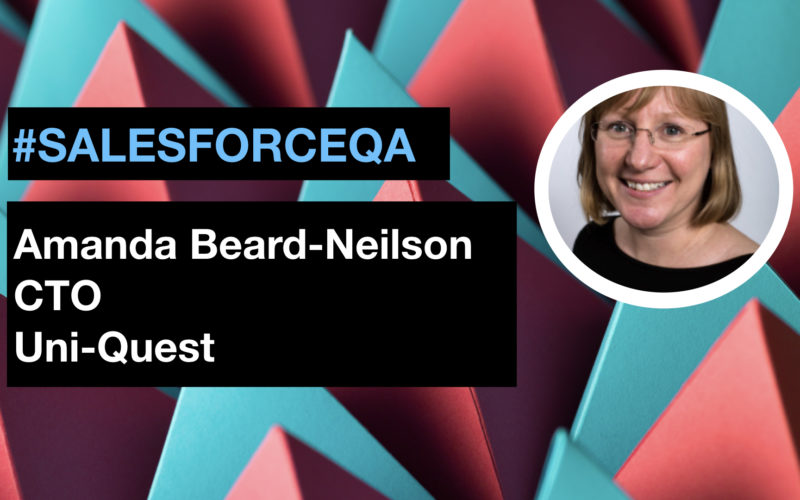The Salesforce ecosystem is absolutely huge. In fact, it is estimated to be worth around 7.3 billion dollars by 2020, and to create 3.3 million new jobs by 2022. But one of the real beauties of this universe is the speed at which it adapts and changes, and how it is driving and defining the technology of the future.
In Third Republic’s Tech Leaders Q&A Series, we speak to industry leaders about what changes they have seen in the Salesforce universe, where they think it is heading, and what this means for those working in the ecosystem today.
Recently, we caught up with Amanda Beard-Neilson, CTO at Uni-Quest to hear her thoughts on how Salesforce is advancing, the impact of these changes, and how it is leading the way in tackling gender disparities in tech.
Third Republic (TR): Can you give us an overview of your background? How did you come into Salesforce?
ABN: My entrance into the Salesforce world was like many others; as the accidental Admin. I fell into it when my director said we needed to find a CRM in order to understand who our customers were, and I was tasked with finding a system and chose Salesforce as it looked intuitive to use. I worked alongside the partner consultant for the implementation and then became the Admin, producing reports for the Board, adding enhancements and ensuring people were adopting the system.
This gave me an amazing starting point for learning about Salesforce and, as I progressed with my career in other departments and roles I realised that I wanted to specialise in it. Since then I have moved between contracting, consulting and working for end-users in a wide range of roles, so I guess you can say I’ve worn many hats in the Salesforce world.
TR: If you could give yourself some advice when you first started your Salesforce journey, what would you say?
ABN: Salesforce has changed massively since I began. It has become more accessible for people to learn and succeed, so I would say to take advantage of all the resources available to you from Trailhead, Certifications, Community User Groups, Salesforce Saturdays, Community Events, World Tours and more.
My advice would be to absorb yourself from the beginning; if you think you are excited by Salesforce and want to make a career out of it there are so many ways you can. Always ask questions, and truly understand the platform and the soul of Salesforce.
TR: How has the Salesforce world changed in your time working in it?
ABN: There has been a huge shift in the capabilities of the platform – when I started there wasn’t this idea of all the different clouds; it was just an advanced Sales tool. Now, there’s IOT and Data, Einstein, Lightning and all the Application Clouds.
Salesforce is completely configurable, and you are only limited by your imagination and your budget. To put it in perspective, when I started using Salesforce, 11 years ago, AppExchange had only just come out, and now there are over 3000 apps that can enhance your Salesforce experience.
TR: What emerging Salesforce trends are you most excited about, and why?
ABN: I think the biggest thing is the whole Einstein piece. Currently, 84% of company Execs know that AI is important, but 38% of those businesses have not defined their own strategy.
There is a potential impact of how AI learns, as studies have found that AI could pick up gender and ethnic biases based on its human data sources and how the system then learns from them, so we have to be mindful of our interactions with it. It will be interesting to see how Salesforce continues to develop its AI offering via Einstein over the next few years.
TR: How do you see Salesforce fitting into the era of digitalisation and digital transformation?
ABN: Digital transformation has been an industry buzzword for a while now, but most companies don’t have a long-term plan for it. So many crash into action as they know they have to do it but end up not giving the right level of investment to tech that it really needs.
Technology is moving so quickly that it requires a continuous plan and budget for transformation. The beauty of Salesforce is that it recognises the need for continuous development and, with its 3 releases a year, they are forever challenging what is new. Although the majority of its existing customers all use the same key objects, if Salesforce didn’t continue to innovate then we as customers wouldn’t be so eager to learn more.
They are at the forefront of continuous technology improvement and we would be wise to follow in their digital footsteps.
TR: What are some of the key challenges that Salesforce professionals need to overcome in this increasingly digital world?
ABN: It’s a challenge to know everything that the Salesforce platform can offer, especially when it is constantly being updated with new features. I suggest you specialise, such as an Admin or Developer and delve into the certifications to help improve your knowledge and show your level of expertise to the community.
Keeping up to date with the new releases and understanding what the platform can provide is the real measure of success in the industry and shows the level of quality of the professional.
TR: Do you perceive there to be a skills gap in the Salesforce world?
ABN: Yes, as more businesses adopt Salesforce they quickly recognise the desire to enhance from the initial implementation and resources are required. This is often how the accidental Admin role is created.
There continues to be a delta in the number of experienced professionals in relation to the needs of the wider market. It can be hard to find the right person for each role as I believe it is important to maintain high standards of knowledge and best practice.
TR: So, do you think professionals now need different skills than previously, in order to be successful?
ABN: Professionals in this market will always need the technical know-how; the understanding of the system including best practice and standards, core certifications, and the desire to continue learning with each release. But now, the softer skills almost outweigh the others.
If you come into a team you can potentially learn the technical stuff from someone else, but if you can’t communicate, collaborate and be a team player, and if you can’t identify what the problem is, understand the outcome and find a solution, then you will struggle.
TR: How do you think those with outside knowledge of Salesforce – such as recruiters and internal resourcers – are handling the ever-shifting ecosystem in terms of helping to fill this skills gap?
ABN: I’ve worked with some great recruiters who have excellent knowledge of the industry, who are best placed to suggest roles that suit the candidate’s skill base.
Any new player to the ecosystem (internal and external) will find this task more of a challenge as it is a gift to fully understand all the types of roles that a Salesforce implementation can require and how they knit together. As a User Group Leader for London I encourage anyone to join our group for their own learning benefit, so they may better serve us as candidates in the future.
TR: How do you think the disparity in women in tech can be addressed? Do you think Salesforce has helped the gender imbalance in the tech industry?
ABN: Salesforce is an enabler for anyone to enter into technical career; you don’t need a computer science background to learn the platform and the wide range of roles that are associated with delivery means that a variety of skills are needed. It opens up opportunities for women who want to work in tech. Salesforce, being cloud based, also offers the flexibility on working arrangements so that people with child or aging parent commitments can have the ability to meet those arrangements while still owning a career.
But I think there needs an emphasis on companies to embrace diversity and further close this gap. We’ve just had the gender pay gap report released, and businesses need to accept they must actively try and change the gender imbalance. I’ve heard of one consultancy who, when recruiting for developers requested that for each male CV received, it must come with a female CV at a 1:1 ratio.
It’s taking proactive actions like this to change the gender imbalance in the ecosystem. Technology can empower people, and in particular women, to transform their careers. Now we need to get businesses on board to fully embrace that opportunity, for all our benefit.


